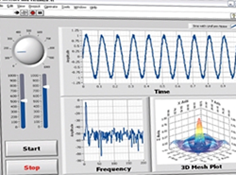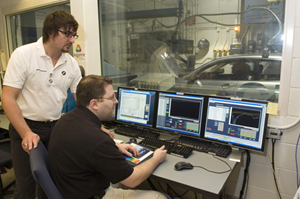
When I was working as an electrician a particularly challenging, but fun, job I worked
on was a steel recycling mill in Kingman, Arizona. The plant was the length of several football fields and was
highly automated. Scrap steel was brought into one end of the building with a massive electromagnet, then melted
in an electric arc furnace, poured into billets, and then rolled into many different types of products.
What was remarkable was that it was designed to operate with a crew of only six people.
This was possible because every operation in the plant was monitored by groups of data-acquiring electronic
sensors. These sensors fed real-time information into a central processing and control center, and a human
operator had to do little more than oversee the feed of scrap metal and select what product the company
wanted it turned into at the other end.
Data acquisition can be just as useful for the benchtop experimenter. In a sense, taking any measurement,
such as a multimeter reading, is a form of data acquisition. The systems we’re talking about here, however,
take your work to the next level and turn tinkering into real science. The ability to record multiple
conditions simultaneously, then graph and analyze them on a computer, can lead to a much better understanding
of the operation of your project. It also allows you to maximize efficiency or performance in a way you
otherwise couldn’t.

Dynamometer testing using multiple sensor measurements and data analysis software.
Courtesy: Argonne Nat. Lab.
The evolution of the PC and serial bus has brought a lot of capability into to the hands of the hobbyist
and experimenter at an affordable level. There are a lot of companies now making data acquisition sensors,
interface modules, and driver and analysis software available. If you’re thinking about a career in science,
industrial electronics, manufacturing, or automation this is a great field to get started experimenting with.
Chris Delvizis is a product engineer with National Instruments, a large manufacturer of data acquisition
hardware and software. I put some questions to him that I thought would be useful and he answered them based
on his real-world experience.
Q. What’s the simplest and least expensive way to get started in experimental data acquisition?
There are a range of data acquisition (DAQ) devices on the market today that include analog inputs,
analog outputs, digital I/O lines, counter/timer circuitry, or a combination of each (multifunction).
For basic applications, you can buy a
USB thermocouple device
for $99, or a
multifunction data acquisition device
for $169. Both devices ship with free measurement software and are great starting points for first-time
DAQ users.
Q. What are the different hardware considerations for a basic PC-based system?
1. Measurements and I/O Types
You should first consider what you are going to measure and what type of signal it is. Signals can be both
analog and digital. For analog measurements, you should consider the number of analog channels, max sampling
rate, resolution, and input signal ranges. Some sensors require signal conditioning for your measurements to
be correct. For instance, strain gauges need bridge completion circuitry. The easiest way to do these types
of measurements is to select a DAQ module with this type of signal conditioning built in such as
NI C Series. For digital
measurements, you should consider the number of digital channels, logic family compatibility, and digital
logic levels.
2. Bus
DAQ devices pass data back to your PC over a PC bus. Because desktop computers are often readily available,
many users choose PCI or PCI Express DAQ boards that plug directly into their computer. However, some prefer
a more portable solution such as a USB device that can plug into desktop computers as well as laptops. For
higher-performance applications, DAQ modules are available for PXI/CompactPCI and PXI Express, a more rugged
modular computer platform specifically for measurement and automation applications. The latest generation of
DAQ devices offer connectivity over wireless and cabled Ethernet.
3. Software and Programming Language
Hardware is really only half of the equation in a PC-based DAQ system. You also need software to take
measurements from the device and control the outputs. There are many software options that you can use
including simpler configuration-based utilities or programming your own custom applications in NI LabVIEW,
ANSI C/C++, Visual Basic .NET, C# .NET, etc.
Q. Collecting sensor data with a 4 – 20 mA signal has been a long-time industry
standard. Is it still, and what trends do you see for the future?
4-20mA current loop sensors are still commonly used today, however, advancements have been made to make
measuring from sensors even easier. Many sensors are available with internal amplifiers that output a raw
voltage so that environmental noise is not an issue and no added signal conditioning is required between
your sensor and your DAQ device. One growing trend we have seen is wireless and Ethernet data acquisition,
which enable measurements to be acquired close to the sensor, reducing the need for long current loop wires.
Q. It’s easy to make mistakes when you’re experimenting or inventing. How do you
protect your hardware from things like over-voltage or static discharge?
First of all, you should make sure to know the input range of your DAQ device and ensure that your input
voltage does not exceed this. For measurements where you are unsure if there may be transient voltage spikes,
you should consider a DAQ device with built-in isolation, which will act as a “surge protector” for high-voltage
transients.
Q. Most people have Excel, or another spreadsheet program, running on their computer
and are familiar with it. A spreadsheet program can make a great data collection and analysis tool. Is this a
good way to go for entry-level data acquisition?
Excel is a common tool for data analysis primarily because many people are already familiar with how to use it.
It is also easy to share Excel files with others. One disadvantage is that it is only capable of offline
visualization and analysis. Many DAQ devices ship with free measurement software with the ability to show
live measurements and sometimes even perform real-time analysis. LabVIEW SignalExpress LE, for example, comes
free with all NI DAQ devices and allows you to record and playback measured data.
Q. What do you see as the most valuable skills to learn for someone considering a
career in data acquisition or industrial automation?
Becoming familiar with the different functions and features of DAQ devices, how to take certain types of
measurements, and the available PC busses is a great start. You can watch these short videos
(
http://www.ni.com/dataacquisition/videos.htm) to for introductory tutorials on data acquisition with your PC.
Also, LabVIEW has seen widespread adoption in the DAQ and industrial automation spaces due to its intuitive
graphical approach, flexibility, and hardware integration. With LabVIEW, you drag-and-drop function blocks
to your block diagram to graphically represent code. Many engineers and scientists choose
LabVIEW because this approach is easier than other
text-based languages like C/C++. Learning and getting certified as a LabVIEW developer is very worthwhile
for engineers, scientists, and students.

